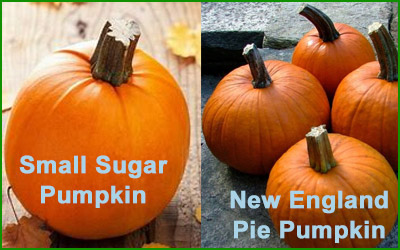Grow Your Own Great Pumpkin Patch in Your New England Garden!
Last Updated:
I don't think anything can stir a child's imagination or excite them about gardening like the thought of growing their own pumpkins at home. Its fun, easy and rewarding to watch them grow before harvest time.
If You Don't Have Space, Stop Reading Now
As much as we love growing pumpkins, it cannot be done in a small garden or a container. Pumpkin vines can reach out 30 or more feet from the base of the plant and can take up huge chunks of your garden space. In addition, the space-hogging pumpkin vine will generally produce only 3-5 decent pumpkins per plant. In spite of all this, if you are ready to give pumpkin growing a chance in your New England garden, read on.
Plan Your Pumpkin Planting Strategy
Knowing these vines will grow like mad, you should definitely plan where they will be rambling during the growing season. The first time we planted pumpkins, they quickly overspread the garden area and headed out into the lawn, eventually overtaking a 2-foot swath of grass about 30 feet long. As a result, we couldn't cut the grass around the plant for about 3 months... not such good planning on our parts.

Start Pumpkins from Seed After Danger of Frost
In the warm weather here in New England, pumpkins will sprout rather quickly, usually within a week at the most. Choose your variety based on what you plan to do with the pumpkins. Large carving pumpkins usually aren't so good for pie, and the small "sugar" pumpkins are usually too small for carving but work great in the kitchen. They are known for their thick flesh, high sugar content and delicious taste in pies and other recipes.

Plant about 3-5 seeds about 2 inches apart in a location where they will be able to grow. Once the seeds sprout, we usually thin the seedlings to just one or two plants. Believe me, just one plant can produce a mighty vine. Unlike some other vining fruits and vegetables, we noticed that pumpkins will send additional roots down at different points throughout the vine, so planting them in an area where there is quite a bit of soil (or even grass) is beneficial, because it will allow the pumpkin to take in additional moisture and nutrients far from its original roots. It also offers some protection from squash borer bugs, who can bore into the vine and kill the plant. If it has additional roots further down the vine, your plant will survive to give you a great harvest in the fall.
Pumpkins Like a Good Solid Watering with Drying Out Periods In-Between
Because pumpkins and their vines are very fleshy, they tend to drink a lot of water. Water deeply about twice weekly unless mother nature is helping you out in that department. Its not unusual to see pumpkin vine leaves wilting during the heat of the summer sun... don't worry, once the sun sets, they will generally pop back up again. If they don't, it means your pumpkins need water.
How Do I Know When To Harvest My Pumpkins?
That's an easy one! Late summer or early fall here in New England gardens, your pumpkins will turn from a light green to the familiar orange. Depending on where you live in New England, that could be as early as late August or as late as the end of September. If you are trying to hold out until Halloween, you can leave them on the vine as long as the vine stays green. Just be careful not to leave it on the vine too long or it will rot. To keep your pumpkin in storage for a few weeks, just keep it in a cool dry location. When you're ready, pull it out and get carving and baking! If you're inclined, rinse the seeds and spread them out on a baking tray. Coat lightly with vegetable oil and salt. Place them in a 375 degree oven until they start to brown slightly, about 10 minutes. Remove and enjoy, they're delicious and healthy!